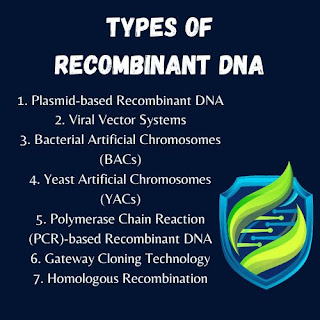In the realm of molecular biology, the term "recombinant DNA" stands as a testament to the ingenuity and progress achieved by scientists in manipulating the building blocks of life. Recombinant DNA technology has opened new avenues in genetic engineering, allowing researchers to combine genetic material from different sources, creating unique and customized sequences. In this comprehensive exploration, we delve into the intricate world of recombinant DNA and unravel the various types that have revolutionized the landscape of biological research.
1. Plasmid-based Recombinant DNA
At the core of many genetic engineering endeavors lies the
utilization of plasmids. These small, circular DNA molecules exist
independently of the chromosomal DNA and are often employed as vectors to carry
foreign genes into host organisms. Researchers harness plasmid-based
recombinant DNA technology to introduce specific genes into target cells,
enabling the production of desired proteins or the alteration of cellular
functions.
2. Viral Vector Systems
In the pursuit of precision, scientists have turned to viral
vector systems as powerful tools for gene delivery. Viruses, known for their
ability to infiltrate host cells, can be modified to serve as carriers for
recombinant DNA. This approach not only ensures efficient gene transfer but
also enables targeted modification of the host genome. Viral vectors play a
pivotal role in gene therapy and the development of vaccines.
3. Bacterial Artificial Chromosomes (BACs)
For researchers seeking to manipulate larger DNA fragments, Bacterial
Artificial Chromosomes (BACs) offer a sophisticated solution. These
vectors, derived from bacterial cells, can accommodate extensive genetic
material, making them ideal for studying complex genomes. BACs have become
instrumental in genomic research, facilitating the mapping and sequencing of
genes in various organisms.
4. Yeast Artificial Chromosomes (YACs)
Yeast, a unicellular organism, has proven to be a valuable
ally in the realm of genetic engineering. Yeast Artificial Chromosomes
(YACs) mimic the structure of natural chromosomes, allowing for the stable
maintenance and replication of large DNA fragments. Researchers leverage YACs
for cloning and manipulating genomic DNA, particularly in the study of
eukaryotic organisms with complex genetic makeup.
5. Polymerase Chain Reaction (PCR)-based Recombinant DNA
In the era of molecular diagnostics, the Polymerase Chain
Reaction (PCR) has emerged as a game-changer. PCR-based recombinant DNA
technology enables the amplification of specific DNA sequences, providing
researchers with an arsenal for gene cloning, sequencing, and analysis. This
approach has become indispensable in various scientific disciplines, from
forensic science to medical research.
6. Gateway Cloning Technology
Simplifying the intricacies of genetic manipulation, Gateway
Cloning Technology has gained prominence for its efficiency and
versatility. This system employs site-specific recombination, allowing
researchers to transfer DNA fragments seamlessly between different vectors.
Gateway cloning has streamlined the process of creating expression constructs,
expediting research in functional genomics.
7. Homologous Recombination
At the heart of genetic diversity lies the phenomenon of homologous
recombination. This natural process involves the exchange of genetic
material between homologous chromosomes, contributing to the evolution and
adaptation of species. In the laboratory, scientists harness homologous
recombination to introduce precise genetic modifications, paving the way for
advancements in gene therapy and biotechnology.
Navigating the Future of Recombinant DNA
The tapestry of recombinant DNA is woven with diverse threads,
each representing a unique approach to genetic manipulation. From plasmids and
viral vectors to artificial chromosomes and cutting-edge cloning technologies,
the landscape of recombinant DNA is continually expanding. As we navigate the
intricate paths of molecular biology, these varied types of recombinant DNA
stand as pillars of innovation, driving scientific breakthroughs and shaping
the future of genetic engineering.








